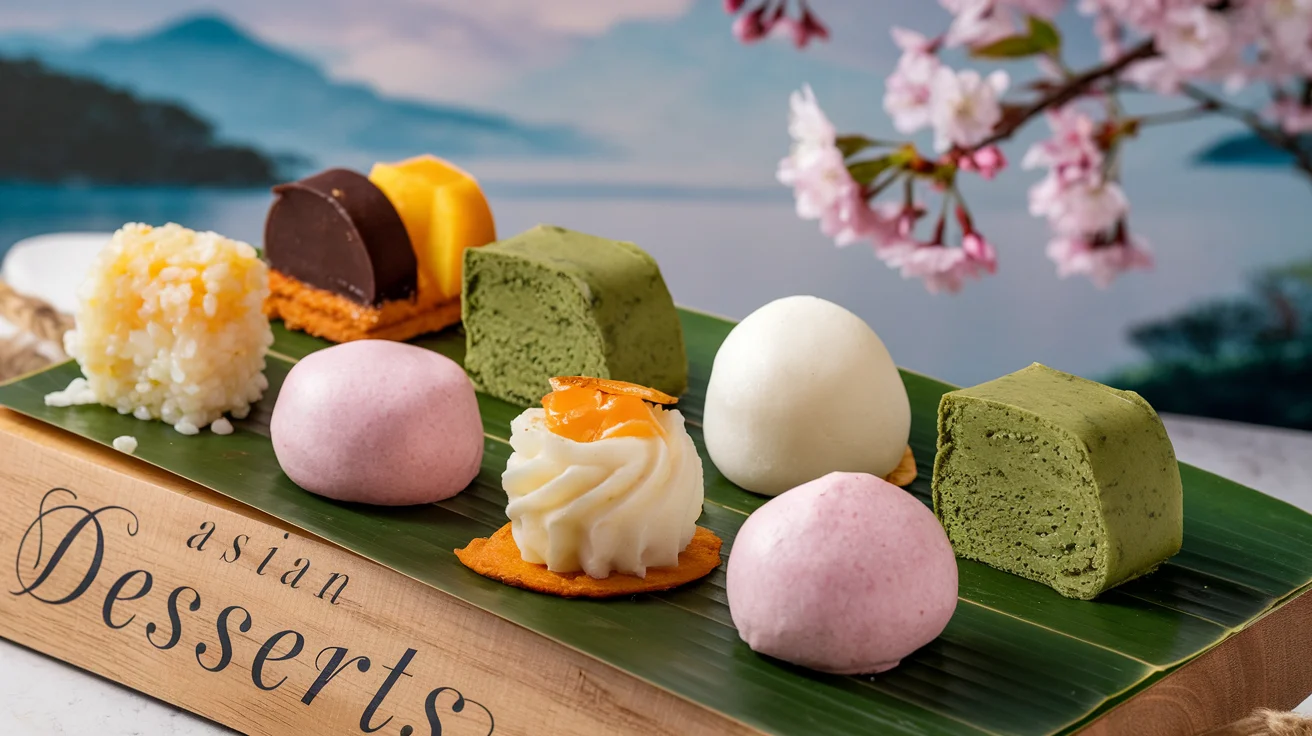When was the last time you indulged in a dessert that transported you to another part of the world? Asian desserts are more than just sweet treats; they are a celebration of culture, history, and unique flavors. Whether you have a sweet tooth or are simply curious about global cuisines, these 10 must-try Asian desserts promise to captivate your senses and leave you craving more.
Table of Contents
Why Asian Desserts Are a Must-Try
A Cultural Experience on Your Plate
Asian desserts are deeply rooted in tradition. They’re not just about satisfying your cravings but also about celebrating festivals, family gatherings, and centuries-old customs. For instance, mooncakes are a staple of the Mid-Autumn Festival in China, symbolizing unity and togetherness.
Unique Ingredients That Amaze
One of the reasons Asian desserts stand out is their use of distinctive ingredients. From the earthy aroma of matcha (green tea powder) to the rich, nutty flavor of black sesame, these components bring a whole new dimension to desserts. Other staples include glutinous rice, red bean paste, tropical fruits like mango and jackfruit, and fragrant pandan leaves.
Textures and Flavors Like No Other
Asian desserts offer a sensory adventure. Imagine the chewiness of mochi, the silky smoothness of caramel custard, or the refreshing coolness of halo-halo. These desserts cater to a wide range of palates, blending sweet, savory, and even umami flavors in ways that surprise and delight.
The 10 Must-Try Asian Desserts
1. Mango Sticky Rice (Thailand)
A beloved Thai dessert, mango sticky rice combines sweet glutinous rice with ripe mango slices and creamy coconut milk. The result? A perfect balance of sweetness and richness that’s hard to resist.
Key Ingredients:
| Ingredient | Quantity |
|---|---|
| Glutinous rice | 1 cup |
| Coconut milk | 1 cup |
| Ripe mango | 1 large |
| Sugar | 2 tbsp |
| Salt | 1/4 tsp |
Pro Tip:
Serve this dish slightly warm, with an extra drizzle of coconut milk for added decadence.
2. Mochi (Japan)
Mochi, a chewy rice cake, is a Japanese classic that comes in various forms. Whether stuffed with sweet red bean paste or wrapped around a ball of ice cream, mochi offers a delightful texture and flavor.
Popular Variants:
- Daifuku Mochi: Filled with red bean paste.
- Matcha Mochi: Infused with green tea powder.
- Ice Cream Mochi: A modern twist, combining mochi with creamy ice cream.
3. Halo-Halo (Philippines)
This colorful dessert is a tropical paradise in a bowl. Halo-halo, which means “mix-mix” in Filipino, features shaved ice, sweet beans, tropical fruits, and leche flan, all topped with ube (purple yam) ice cream.
Key Ingredients:
- Shaved ice
- Condensed milk
- Jackfruit
- Red beans
- Ube halaya (purple yam jam)
Fun Fact:
Halo-halo is as much about the experience as it is about the flavors. The joy lies in mixing all the ingredients together before taking your first bite.
4. Bánh Flan (Vietnam)
A Vietnamese take on caramel custard, bánh flan incorporates coconut milk for a subtle tropical twist. This dessert is creamy, silky, and perfect for those who love a rich yet light treat.
5. Mooncakes (China)
Mooncakes are dense pastries typically filled with lotus seed paste or red bean paste and often feature intricate designs on their crusts. They’re traditionally enjoyed during the Mid-Autumn Festival.
Cultural Note:
Mooncakes symbolize reunion and harmony, making them a meaningful gift during the festival season.
6. Gulab Jamun (India)
Gulab jamun consists of deep-fried milk balls soaked in a fragrant rose-scented sugar syrup. This Indian dessert is rich, indulgent, and often served at weddings and celebrations.
Pro Tip:
Serve warm with a sprinkle of crushed pistachios for added texture and flavor.
7. Pandan Waffles (Vietnam)
These vibrant green waffles owe their color and flavor to pandan, a tropical plant known for its sweet, floral aroma. They’re crispy on the outside and soft on the inside, making them a popular street food.
8. Dango (Japan)
Dango are skewered rice dumplings glazed with a sweet soy sauce. They’re a popular snack during Japanese festivals and come in various types, such as mitarashi dango (sweet soy glaze) and hanami dango (colorful balls enjoyed during cherry blossom season).
9. Cendol (Malaysia/Indonesia)
Cendol is a refreshing dessert made of green jelly noodles, coconut milk, and palm sugar syrup. It’s perfect for cooling down on a hot day.
10. Black Sesame Soup (China)
This warm dessert soup is made with ground black sesame seeds, water, and sugar. Its nutty, slightly bitter flavor makes it a unique choice for those looking to try something different.
How to Enjoy These Desserts at Home
Tips for Success:
- Use Authentic Ingredients: For the best flavors, source authentic ingredients from Asian grocery stores or online retailers.
- Invest in Essential Tools: A rice cooker, bamboo steamer, or ice shaver can make preparation easier.
- Follow Tried-and-True Recipes: Look for recipes with high ratings or step-by-step videos to guide you.
Where to Buy Ingredients:
- Local Asian grocery stores
- Online marketplaces like Amazon or specialty food websites
FAQs About Asian Desserts
What makes Asian desserts unique?
Asian desserts stand out for their use of ingredients like glutinous rice, tropical fruits, and beans, which create distinct textures and flavors.
Are Asian desserts difficult to make at home?
Not at all! Many recipes, like mango sticky rice or mochi, are simple and require minimal ingredients.
Where can I find authentic Asian desserts?
You can explore Asian bakeries, specialty dessert shops, or try making them at home using the recipes shared above.
Conclusion
Asian desserts are a treasure trove of flavors, textures, and cultural significance. Whether you’re savoring the chewy goodness of mochi, the refreshing layers of halo-halo, or the rich indulgence of gulab jamun, each dessert tells a story. Why not embark on this sweet journey and discover your new favorite treat? Let us know which dessert you’ll try first in the comments below!
